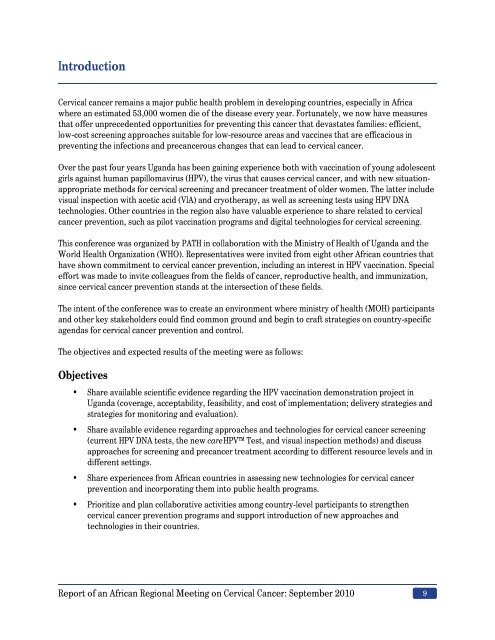Download file, English (1 MB PDF) - RHO
Download file, English (1 MB PDF) - RHO
Download file, English (1 MB PDF) - RHO
Create successful ePaper yourself
Turn your PDF publications into a flip-book with our unique Google optimized e-Paper software.
Introduction<br />
Cervical cancer remains a major public health problem in developing countries, especially in Africa<br />
where an estimated 53,000 women die of the disease every year. Fortunately, we now have measures<br />
that offer unprecedented opportunities for preventing this cancer that devastates families: efficient,<br />
low-cost screening approaches suitable for low-resource areas and vaccines that are efficacious in<br />
preventing the infections and precancerous changes that can lead to cervical cancer.<br />
Over the past four years Uganda has been gaining experience both with vaccination of young adolescent<br />
girls against human papillomavirus (HPV), the virus that causes cervical cancer, and with new situationappropriate<br />
methods for cervical screening and precancer treatment of older women. The latter include<br />
visual inspection with acetic acid (VIA) and cryotherapy, as well as screening tests using HPV DNA<br />
technologies. Other countries in the region also have valuable experience to share related to cervical<br />
cancer prevention, such as pilot vaccination programs and digital technologies for cervical screening.<br />
This conference was organized by PATH in collaboration with the Ministry of Health of Uganda and the<br />
World Health Organization (WHO). Representatives were invited from eight other African countries that<br />
have shown commitment to cervical cancer prevention, including an interest in HPV vaccination. Special<br />
effort was made to invite colleagues from the fields of cancer, reproductive health, and immunization,<br />
since cervical cancer prevention stands at the intersection of these fields.<br />
The intent of the conference was to create an environment where ministry of health (MOH) participants<br />
and other key stakeholders could find common ground and begin to craft strategies on country-specific<br />
agendas for cervical cancer prevention and control.<br />
The objectives and expected results of the meeting were as follows:<br />
Objectives<br />
• Share available scientific evidence regarding the HPV vaccination demonstration project in<br />
Uganda (coverage, acceptability, feasibility, and cost of implementation; delivery strategies and<br />
strategies for monitoring and evaluation).<br />
• Share available evidence regarding approaches and technologies for cervical cancer screening<br />
(current HPV DNA tests, the new careHPV Test, and visual inspection methods) and discuss<br />
approaches for screening and precancer treatment according to different resource levels and in<br />
different settings.<br />
• Share experiences from African countries in assessing new technologies for cervical cancer<br />
prevention and incorporating them into public health programs.<br />
• Prioritize and plan collaborative activities among country-level participants to strengthen<br />
cervical cancer prevention programs and support introduction of new approaches and<br />
technologies in their countries.<br />
Report of an African Regional Meeting on Cervical Cancer: September 2010 9
















